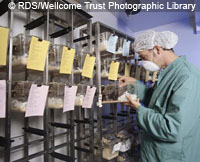Commission launches consultation on welfare of laboratory animals
The European Commission has launched an online consultation of citizens and experts on how to increase the welfare of animals used in experiments. The results of the survey will inform the Commission's forthcoming proposal to revise the existing EU legislation on the issue. The consultation consists of two questionnaires - one aimed at the general public, the other at experts. The public questionnaire is available in all 20 official EU languages and seeks to determine the public's view on when animal testing is acceptable, what animals should be used, and whether the existing legislation does enough to protect animals used in experiments. The second questionnaire is more detailed, and is aimed at experts in animal welfare, animal testing, animal science, natural science and legal and economic affairs related to these areas. It invites experts to comment on the preliminary findings of an impact assessment on the options for the revision of the current legislation. The current EU directive on the welfare of animals used in experiments was passed in 1986. It sets out the licensing requirements for establishments wishing to carry out animal experiments, and includes guidelines on housing and care of laboratory animals, and ensures the appropriate use of anaesthesia, to avoid unnecessary pain and suffering. It also encourages the development of alternatives to animal testing, and requires that animal experiments should not be performed if alternative methods exist. However, since the directive was adopted, new techniques have become available, such as the use of transgenic animals (animals produced with externally introduced genes), xeno-transplantation (where tissue, organs or cells are transplanted from one species to another) and cloning. None of these issues are addressed in the current directive. The use of animals with a higher degree of neurophysiologic sensitivity, such as non-human primates, is also not specifically regulated. The European Commission plans to publish a proposal revising the 1986 directive in early 2007. The overall aim of the revision is to achieve harmonised, controlled use of animals in scientific procedures with a high degree of animal welfare and transparent practices across the EU. It will also address issues which have arisen since 1986, and take into account ethical and other concerns. It will seek to find a balance between controlling the use of animals in experiments and ensuring the EU stays at the leading edge of research.



